Search Results for: weeds
Don’t Make Your Trees Compete. Remove Grass & Weeds!

By Erica Timm
Trees can provide us with many, many years of amazing benefits—shade, beauty, stormwater management, increased property values, just to name a few—but first we, as their stewards, need to make sure they thrive through their first few years in the ground.
Water is the number one resource that newly planted trees need during their first few years in the ground in order to survive. While making sure you provide your newly planted trees with 10-15 gallons of water each week is a great start, removing weeds and grass growing within 18 inches of the tree trunk ensures that all of that water actually reaches the tree roots.
Plants compete with their neighbors for water, resources and rooting space. The majority of the fine, water-absorbing tree roots can be found in the top six inches of soil. This is the same space that the majority of grass and weed roots are also found. It is more difficult for the newest plant in the landscape to compete with more established plants. So it’s especially important that the grass and weeds surrounding a newly planted tree are continuously removed.Read More
February 2022

|
Learn more about how Friends of Trees greens our region + grows community through checking out other issues of Treemail here https://friendsoftrees.org/news-resources/treemail.
The Eugene Branch Walks the Talk in their own Backyard
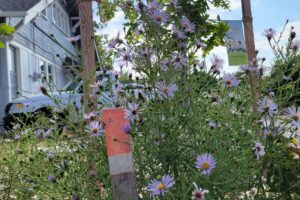
A year ago, if you were to look out the back window of the Friends of Trees office in Eugene, you might look past the small backyard and see nearly a block of impermeable surfaces, power lines, parking lots and buildings. But our staff saw an opportunity, and went about converting their backyard into an oasis of nature.
“We had left our mark at our last office,” says Eugene Director Erik Burke. There, they partnered with City of Eugene on a Trees for Concrete project, removing concrete and planting eight trees along the busy street outside the old office—two Oregon white oaks, two California black oaks (see this month’s Leaflet for why Oaks are such an awesome choice), three Persian ironwoods, and a Chinese pistache, as well as valley pine and bigleaf maples on the east side of the building.
After moving one block south to a new office, they were compelled to do something similar. “It’s the only unpaved patch in a sea of concrete,” says Erik. “We wanted to make the most of it.”
“We try to walk the talk,” says Volunteer & Program Specialist Taylor Glass. So they pulled away all the grass and weeds, put down cardboard and mulch, and put in a variety of native, drought tolerant, and pollinator friendly plants: 2 Oregon white oaks, red flowering currant, Douglas’ aster, camas, showy milkweed, manzanita, and nootka rose (and some volunteer California poppies have made the backyard their home too!).
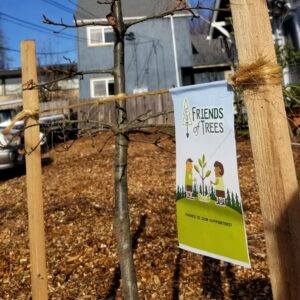
“Douglas aster is one of the best plants for pollinators due to its really long bloom time,” Taylor says. “Last year the asters in our backyard continued blooming into October!”
“We wanted all the plants to be climate resilient and drought tolerant,” Erik Says. “After a few years of getting the plants established, we hope to never have to water, no matter what climate change throws at us.”
It’s all about making an impact and leaving a legacy in their community. They are benefiting from that legacy already. In front of the office are bigleaf maples that were planted 14 years ago as part of another Trees For Concrete program, back when FOT Eugene was still the Eugene Tree Foundation. “We planted them many years ago, not knowing that we would end up getting to enjoy them outside our office,” Erik says.
Now the office’s backyard has grown into a beautiful native plant garden, attracting hummingbirds, butterflies and bees, and giving our staff a daily dose of inspiration.

Get To Know ChipDrop
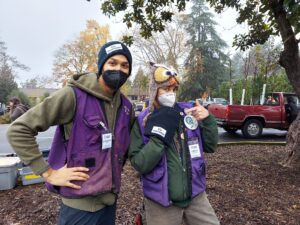
You know that we’re big fans of mulch at Friends of Trees, and we use a lot of it. That’s why we are so excited about our partnership with ChipDrop, an app that matches people who want free wood chip mulch with arborists and tree companies who are trying to get rid of it. Instead of taking wood chips to the landfill, arborists can drop them off right at your garden.
“We wanted to get involved with organizations that are on the same page,” says ChipDrop Co-Founder Andrea Kappa. “Friends of Trees is already in the business of educating people about the benefits of mulch, amending your soil, and growing what you want to grow.”
ChipDrop sponsored four Friends of Trees plantings this year. We picked plantings in neighborhoods that already had ChipDrop activity, so it was an opportunity to educate people about wood chip mulch that could be available to them.
“There are plenty of people who are on the fence about it or don’t understand it,” says ChipDrop Co-Founder Bryan Kappa. “Partnering on plantings is a great way to help people understand the benefits.”
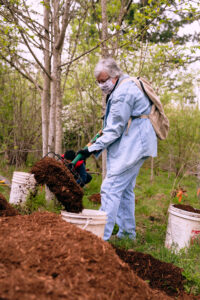
Think of what you can do with a truckload of mulch. “You can spread more than just a thin layer, and it will really amend your soil,” Bryan says. “So many people get frustrated that they can’t grow what they want to grow, and this is a way to do that.”
Beyond that, ChipDrop keeps material local and out of the landfill. If your neighbor has a tree taken down, that could become your wood chip mulch.
Of course, mulch is very important for newly planted urban trees. It reduces evaporation, delivers organic nutrients, and helps prevent the growth of weeds.
“Urban canopy is so important,” Andrea says. “Friends of Trees is taking huge leaps towards that. We’re super grateful for Friends of Trees as our first sponsorship. You’re such great supporters of what we do, and we foresee the partnership continuing into the future.”
Leaflet: It’s Time To Put Down Some Roots
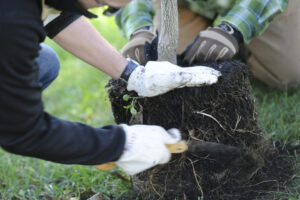
Last month, we told you why you should leave the leaves. We got such great feedback that we decided to create a regular tree care column, Leaflet, so that our eager experts can pass on their knowledge. We’ll share best practices for tree care and maintenance, explore common myths and misconceptions, and dig into the science behind it all.
“Now that the leaves are on the ground, we get busy,” says Neighborhood Trees Senior Specialist Drew Land about the November tree planting season. “Speaking of busy, roots are always busy.” We plant trees now so that while the trees are dormant above ground, they can focus on establishing their roots below ground. From timing to mulching to watering, our strategies help shape the tree’s root system.
“Street trees are not truly part of the urban forest until their roots start to intermingle,” Drew says. That’s why making sure a tree’s roots get established properly is a crucial part of planting and maintenance.
Because roots are almost entirely underground, we don’t really think about the shape of their structure. Rather than just a main tap root that goes straight down, 85% of a tree’s roots are within the top 24 inches of soil, or at least they should be. In the urban environment, roots are often up against the challenge of compacted and nutrient-depleted soil. In situations like these, roots will be too shallow, because they don’t have the space to seek out water and oxygen. Trees in the forest enjoy uncompacted soil with plenty of air and water spaces below ground. This also gives room for the fungal and microbial activity that brings soil to life.
“Roots are opportunists,” Drew says. “They follow the resources.” Given the right moisture and temperature, tree roots can grow year round. Insulation from mulch maintains those conditions, and we spread it in a way that encourages the roots to grow outward. Similarly, we shouldn’t just water at the base of a tree’s trunk, but should aim to water the tips of roots as they grow outward from the trunk. And we should water long enough that it sinks beyond the surface. Deep, infrequent watering mimics natural rain storms and gives roots what they need to spread both outward and downward. “Well-meaning people often shallow water on a daily basis, but that only feeds grass/weeds and not the tree roots a foot below. “
Tree roots come in two main types: structural roots and feeder roots. Structural roots are woody, and serve as the architecture to keep the tree upright. Feeder roots, which are much more like root hairs, are in charge of absorbing water and nutrients.
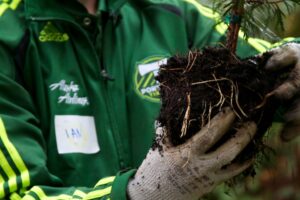
Maybe you have heard the myth that tree roots can grow into your sewer or water pipes and bust them open. Drew is here to officially bust that myth. He says that while roots are opportunistic, they are not invasive. “So the roots are not busting your sewer line,” he promises. “Your line is already busted and the roots found a tasty water source.”
Recreating ideal natural conditions is the best way to ensure that the roots of our urban trees stay healthy. “Roots are like muscles,” Drew says. “They grow in response to stress.” When you tie a newly planted tree too tightly to a support, it won’t have the freedom to move in the wind, building up those root “muscles” to support itself.
Getting the roots established is one of the most important reasons we plant new trees in the fall. “Planting trees now, while they’re dormant, will build their resilience,” Drew says. ”In ten months, when autumn winds hit their leaves for the first time, they’ll be ready.”
Further reading:
- “Roots Demystified” by Robert Kourik
- “Up by Roots” by Jim Urban














